|
Frank O'Hara
in Bolivia
Mid-November to December 2005
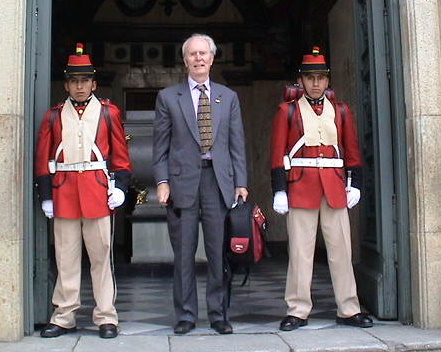
Frank helps the guards
Click here to see a 22 minute
video of some of my experiences in Bolivia
A high-speed connection is
recommended.
Bolivia is a fascinating country.
Here are a few examples: It is the highest
capital city in the world, has the highest navigable lake, and possibly the
friendliest people. Over 65% of the population is indigenous. Most noticeable
on the streets are the Indian women in their exotic garb. Apparently, the
bowler hats are the result of a merchant a couple of hundred years ago who
found himself with a large surplus of such hats. He convinced the wives of the
local gentry these hats were all the rage in Europe (no Internet in those
days!). The women took up the fashion and subsequently were emulated by the
native women.
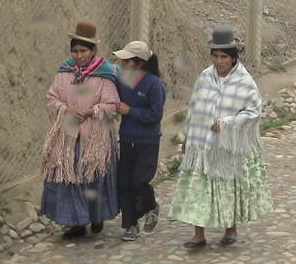 The natives also copied the
style of dress, many crinolines and dresses to the floor. Well, they did adapt
the dress somewhat to local field conditions; the dresses end about 12" from
the ground to facilitate manual labour. The natives also copied the
style of dress, many crinolines and dresses to the floor. Well, they did adapt
the dress somewhat to local field conditions; the dresses end about 12" from
the ground to facilitate manual labour.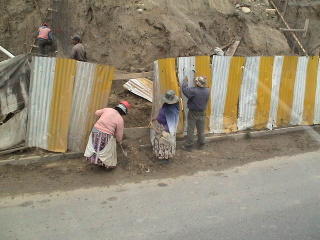 The Indians also made some
other innovations. The hat is worn straight across the top of the head if the
woman is married and cocked to one side if she is "available". Also the skirts
have a pattern that runs either vertically or horizontally, also to indicate
marital status, just in case a man doesn't get the picture with the hat. I have
no idea why the hats must be several sizes too small or how they keep them on.
I saw no sign of bobby pins. The Indians also made some
other innovations. The hat is worn straight across the top of the head if the
woman is married and cocked to one side if she is "available". Also the skirts
have a pattern that runs either vertically or horizontally, also to indicate
marital status, just in case a man doesn't get the picture with the hat. I have
no idea why the hats must be several sizes too small or how they keep them on.
I saw no sign of bobby pins.
La Paz has different climate environments
according to each zone's altitude.
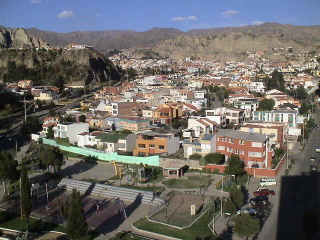
While the centre of town is at 3,650
meters above sea level, the zone of Aranjuez (the suburb where my hotel was
located) is at 3,300 m. El Alto (where the international airport is located) is
at 4,082 m. The average temperature in winter is 15C (59F) and 22C (72F) in
summer. In the summer, rain falls on most afternoons. In the winter (opposite
to North America's), the days are slightly cooler, but the sky is mostly clear
and sunny.
This was the view from my
hotel window. Note the mountains surrounding the city.
This was not a hardship posting. I stayed
in a very modern hotel, with good high speed Internet connections; so I was
able to listen to CBC Toronto on my computer. I had a small living room with an
enormous TV where I could get the usual BBC World, CNN & German (English)
news as well as lots of Spanish stations. There was also a smaller TV in a
separate bedroom. The staff was extremely helpful and pleasant.
The air at 3,650 meters above sea level is
rarefied, to say the least. I heard there is about 15% less oxygen available.
This affects not only people but also cars. They struggle just as human
newcomers to this climate do, although people gradually adjust to it. I carried
an umbrella as a talisman against the sudden rainfalls. It really worked. The
only time I was caught in a downpour was when I neglected to bring along my
umbrella. Bolivia, of course, is in the tropics, and the sun in the Andes burns
even more readily than at lower elevations.
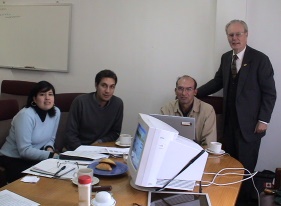 I came to La Paz to help with the promotion of
a website designed to help artisans market their products worldwide via
e-commerce and without the cost of one or more middlemen. I found they had not
actually developed the site, so I had to do it. There were a number of problems
because Bolivians do not have the secure Internet facilities we take for
granted. So, I got in touch with my Toronto ISP to handle the transactions.
Locally, there were some quite knowledgeable people who can design the database
and complete the website I did, including making it bilingual English/Spanish.
When I got back to Toronto, I started organizing the secure payment element.
The website has taken them longer to finish than I thought it would. I came to La Paz to help with the promotion of
a website designed to help artisans market their products worldwide via
e-commerce and without the cost of one or more middlemen. I found they had not
actually developed the site, so I had to do it. There were a number of problems
because Bolivians do not have the secure Internet facilities we take for
granted. So, I got in touch with my Toronto ISP to handle the transactions.
Locally, there were some quite knowledgeable people who can design the database
and complete the website I did, including making it bilingual English/Spanish.
When I got back to Toronto, I started organizing the secure payment element.
The website has taken them longer to finish than I thought it would.
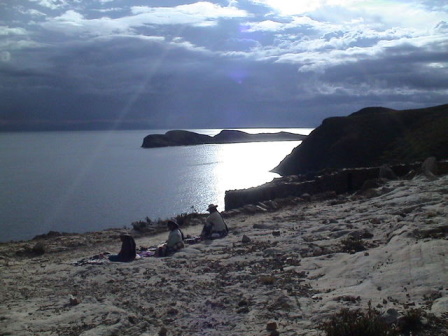
One weekend I visited Lake
Titicaca. It is not only renowned for being up in the clouds, about 500 m
higher than La Paz, but also because it is very beautiful. Here are a few
pictures.
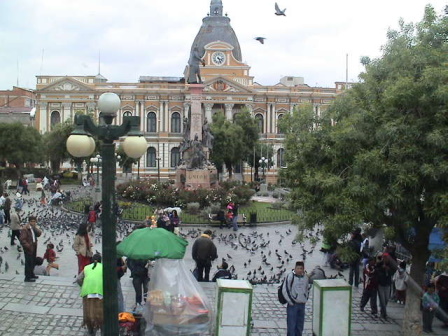 This is the national legislature. The old part of the city of
La Paz has a number of attractive plazas like this one. This is the national legislature. The old part of the city of
La Paz has a number of attractive plazas like this one.
Bolivia is a country made
poverty-stricken by political corruption and mismanagement. For many years, it
has had an average of a president a year. One was shot, one hanged, one
imprisoned for 30 years, and one is resisting extradition from the U.S.A. The
election on December 18, 2005, brought radical change. Because there was a fear
of insurrection - certainly not novel in Bolivia - tourists were avoiding the
country and the small merchants suffered as a consequence. It's the weak who
pay! And yet, Bolivia could be a very rich country. There is every climate from
tropical to desert to high Andean. The country is resource rich (many minerals,
oil and natural gas, and hydro electricity). Why are Bolivians so poor?
Kleptomaniac leaders!
This is a country for shopaholics. Too bad
it is so difficult to reach. (Our plan is for the new website to alleviate this
by enabling people around the world to shop from home for unusual gifts at
terrific prices.) There are about 8 bolivianos to the U.S. dollar. For example,
I had a shoe shine boy tend to my shoes. The cost: 4 bolivianos. Being a
big-time tipper, I gave him five. (Later I found that the normal price for a
shoe-shine is only one boliviano.) Some of the shoe shine boys wear face masks,
something like what skiers in Canada wear on very cold days. They are ashamed
to be supporting their families this way.
Speaking of shame, there is no shame here
in being involved in the coca business. Coca is legal. Coca tea is served in
all restaurants. The tea is not habit-forming and helps alleviate the effects
of oxygen deprivation - a bit of a lift like a cup of coffee. The local Indians
chew coca leaves to help stave off hunger. Of course, there is also a large
coca exporting business and that isn't legal. The new president, the first
aboriginal and a coca farmer, is regarded as a leftist. It is too early to know
what influence he will have. It is a safe bet, though, that he has at heart the
interests of the 65% of the population who are Indian. Interestingly, there are
quite a few Europeans living in La Paz in addition to those of Spanish
extraction. Germans, Croats, and Lebanese are particularly evident and all
quite prosperous, it seems.
The public school system is poorly
supported. People with money send their children to private schools for about
$70 per month each - a fortune for the average person. There are "American" and
"German" and "French" private schools. So, there are lots of people, children
of the wealthy, who speak foreign languages.
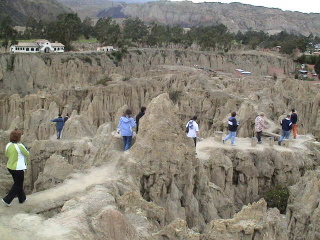 On the left and right is one of the strange mountainous areas
surrounding La Paz. Tourists were scrambling around and then their guide took
their pictures; he's holding a camera for each one. On the left and right is one of the strange mountainous areas
surrounding La Paz. Tourists were scrambling around and then their guide took
their pictures; he's holding a camera for each one.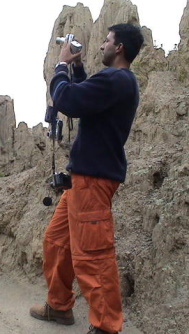
CESO had a very substantial operation here
for about 7 years, but closed it at the end of 2005. Too bad. There is still
lots to be done. There were about 12 - 15 CESO volunteers in the La Paz area
while I was there - finishing off the balance of the budget, I guess. It is
pleasant meeting people from all across Canada - experts in many fields, all
wanting to do something to help people in downtrodden parts of the world and
hoping to make a difference. Canada has a very positive image here, as I have
experienced throughout the world. It is humbling to see how happy people are to
receive a little Canadian flag pin.
Some of the CESO volunteers -
representing Canada coast to coast and the NWT.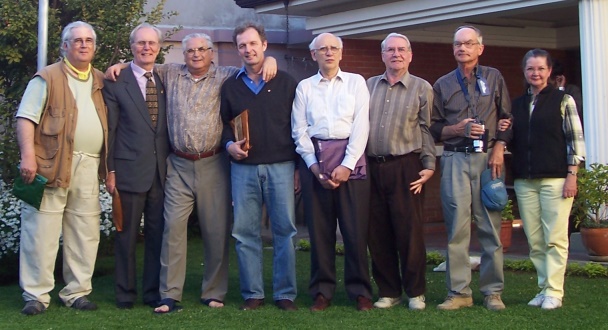
It was strange returning to Toronto's
blustery weather, but I sure appreciated the level of oxygen.
Hasta Mañana
Frank
O'Hara
|
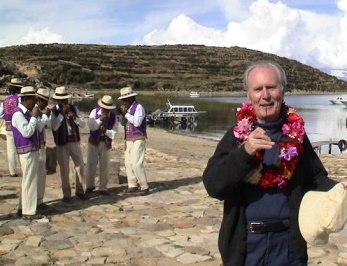
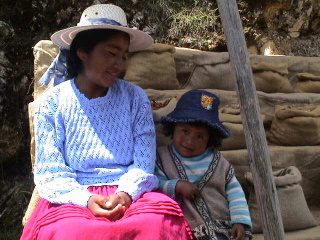
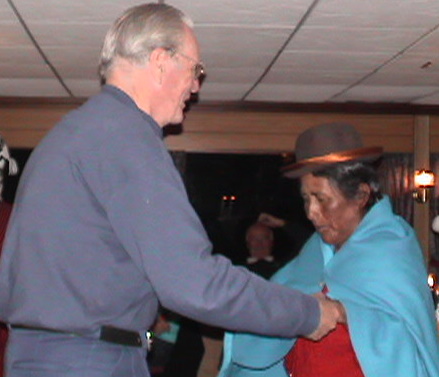
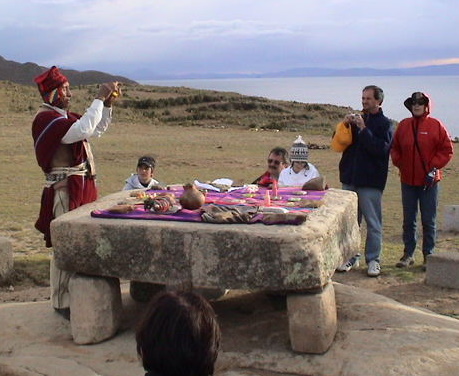




 The natives also copied the
style of dress, many crinolines and dresses to the floor. Well, they did adapt
the dress somewhat to local field conditions; the dresses end about 12" from
the ground to facilitate manual labour.
The natives also copied the
style of dress, many crinolines and dresses to the floor. Well, they did adapt
the dress somewhat to local field conditions; the dresses end about 12" from
the ground to facilitate manual labour. The Indians also made some
other innovations. The hat is worn straight across the top of the head if the
woman is married and cocked to one side if she is "available". Also the skirts
have a pattern that runs either vertically or horizontally, also to indicate
marital status, just in case a man doesn't get the picture with the hat. I have
no idea why the hats must be several sizes too small or how they keep them on.
I saw no sign of bobby pins.
The Indians also made some
other innovations. The hat is worn straight across the top of the head if the
woman is married and cocked to one side if she is "available". Also the skirts
have a pattern that runs either vertically or horizontally, also to indicate
marital status, just in case a man doesn't get the picture with the hat. I have
no idea why the hats must be several sizes too small or how they keep them on.
I saw no sign of bobby pins. 
 I came to La Paz to help with the promotion of
a website designed to help artisans market their products worldwide via
e-commerce and without the cost of one or more middlemen. I found they had not
actually developed the site, so I had to do it. There were a number of problems
because Bolivians do not have the secure Internet facilities we take for
granted. So, I got in touch with my Toronto ISP to handle the transactions.
Locally, there were some quite knowledgeable people who can design the database
and complete the website I did, including making it bilingual English/Spanish.
When I got back to Toronto, I started organizing the secure payment element.
The website has taken them longer to finish than I thought it would.
I came to La Paz to help with the promotion of
a website designed to help artisans market their products worldwide via
e-commerce and without the cost of one or more middlemen. I found they had not
actually developed the site, so I had to do it. There were a number of problems
because Bolivians do not have the secure Internet facilities we take for
granted. So, I got in touch with my Toronto ISP to handle the transactions.
Locally, there were some quite knowledgeable people who can design the database
and complete the website I did, including making it bilingual English/Spanish.
When I got back to Toronto, I started organizing the secure payment element.
The website has taken them longer to finish than I thought it would.

